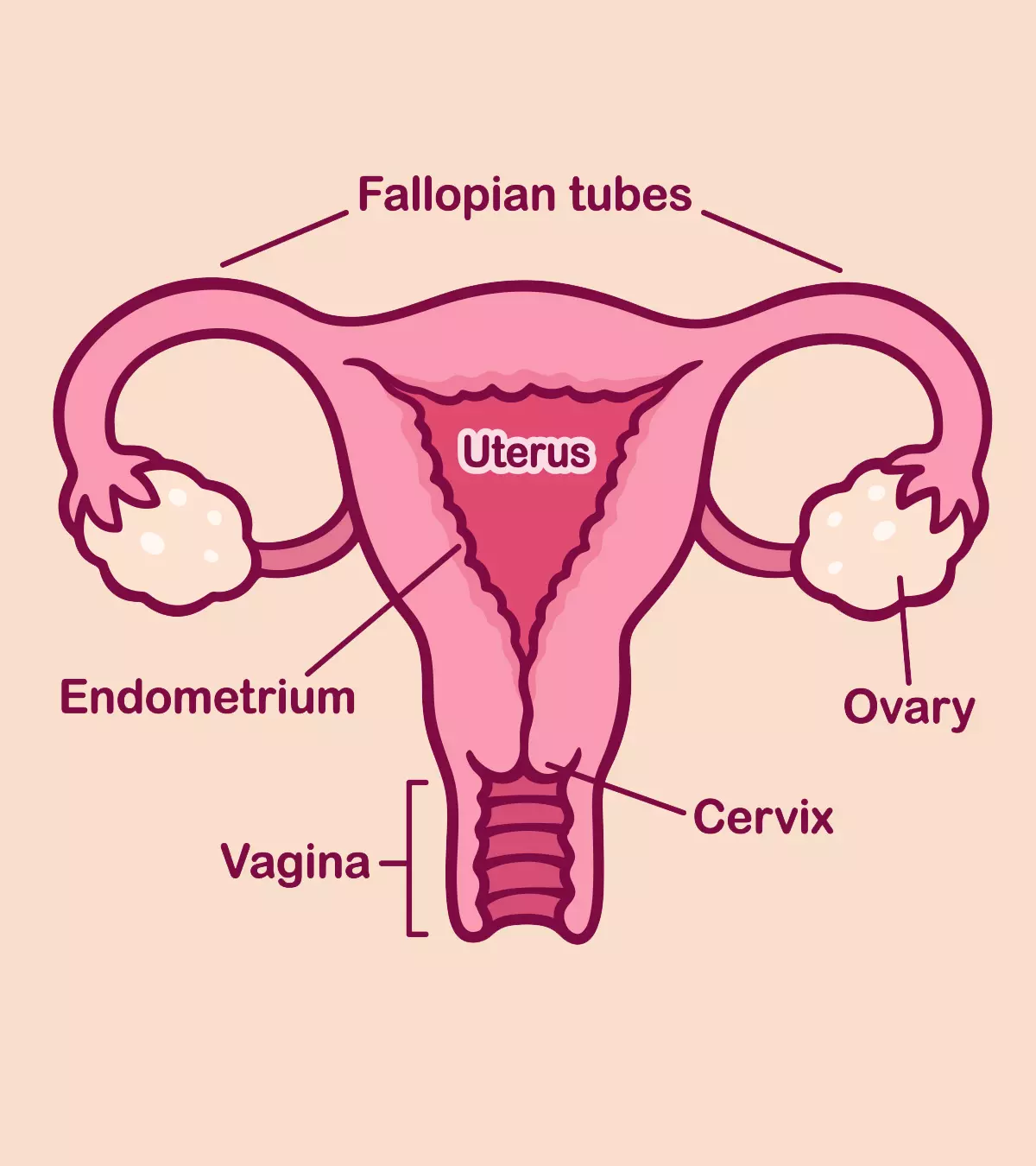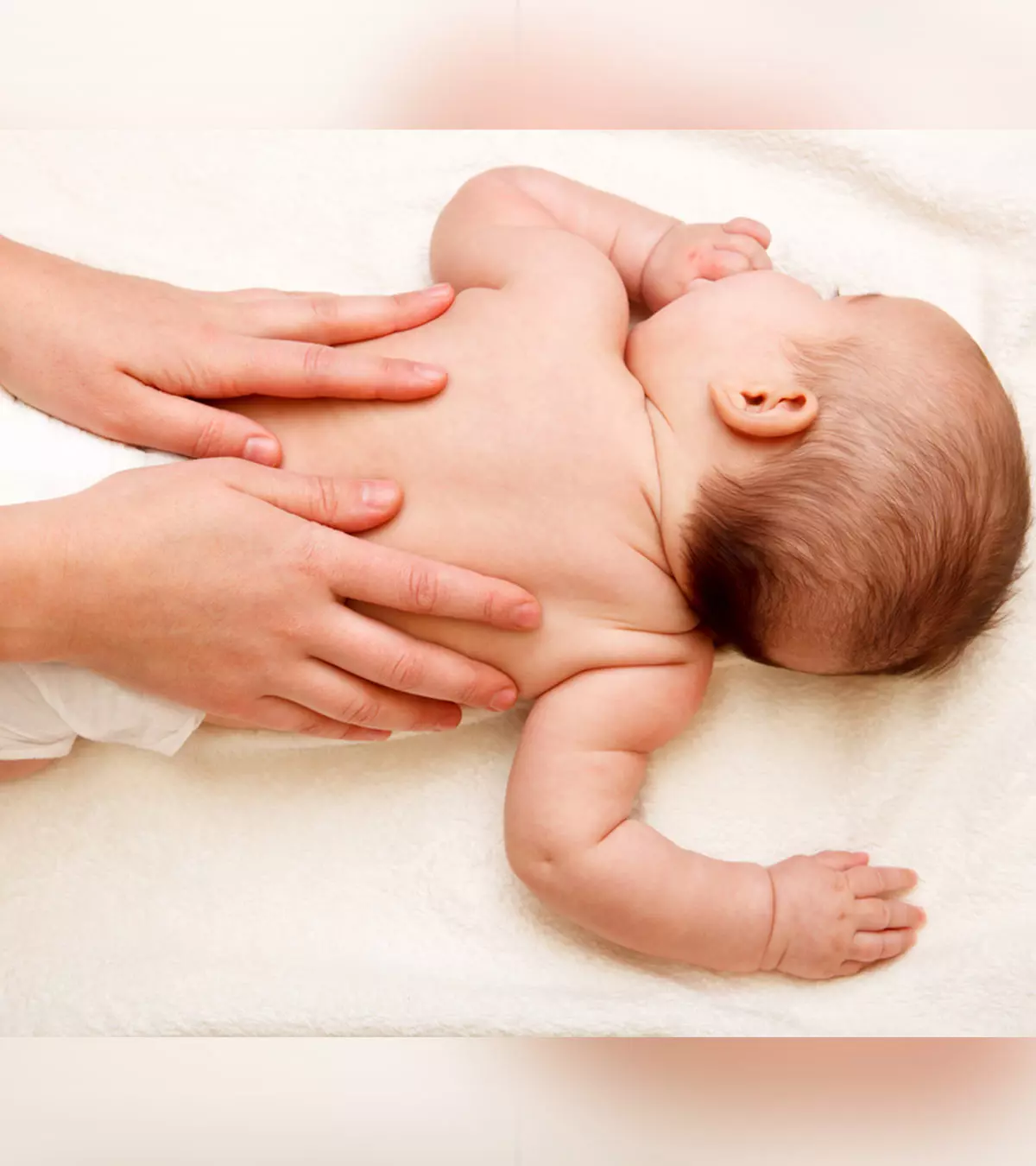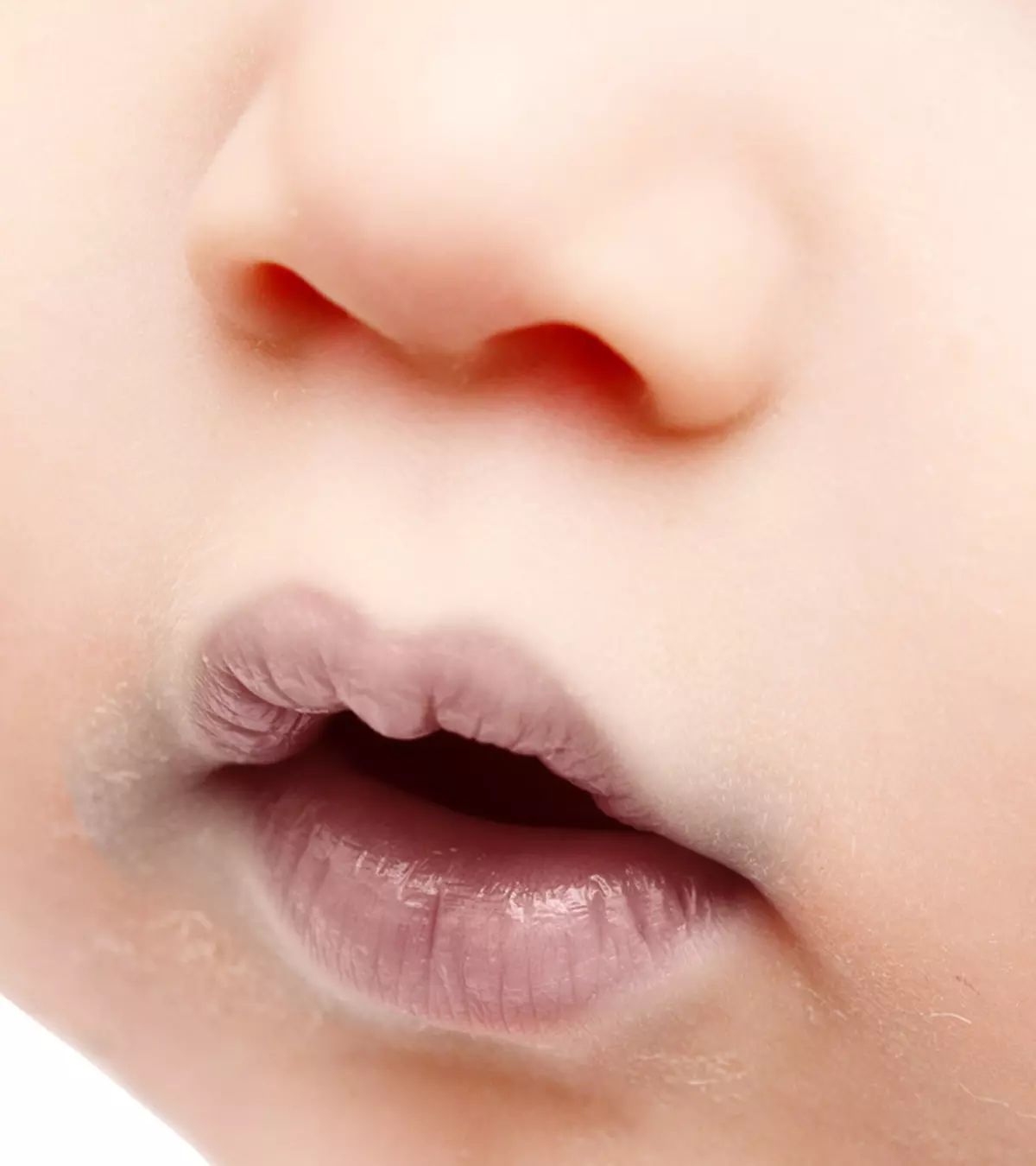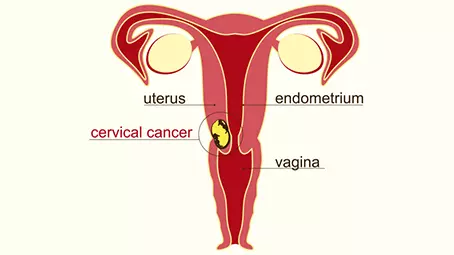
Image: ShutterStock

Feeding tubes for infants serve to provide foods and medicines directly into an infant’s stomach until they learn to swallow. It is a tiny plastic tube that goes through the nose or mouth into the stomach.
There are a few conditions when feeding tubes are used for infants. If the baby has swallowing problems or risk of aspiration into the airway, this form of enteral nutritioniFeeding technique that delivers calories and nourishment through a tube directly into the digestive tract. is preferred. It is used only for babies who show normal stomach and intestinal functions.
Read on to know more about the types of feeding tubes, the indications for requirement, the contraindications, risks, and duration of use.
Key Pointers
- Newborns who can’t breastfeed or bottle feed may require tube feeding.
- Pediatricians recommend tube feeding if there is an absence or weak sucking or/and swallowing reflex, no weight gain, or gastrointestinal issues.
- Tube feeding has several types based on the insertion point (mouth/nose) to its final location (small intestine).
- Proper tube placement is crucial to avert the risk of issues, such as coughing, vomiting, and breathing difficulties.
- Tube feeding can continue until the baby learns to feed or feeding difficulties are resolved.
Why Does A Newborn Need A Feeding Tube?
Newborns who cannot feed themselves from the breast or bottle require a feeding tube. Breastfeeding or bottle-feeding requires strength and coordination. The infant should be able to suck and swallow from the breast or bottle nipple. If a baby is unable to do so or is premature, a healthcare provider may recommend a feeding tube to ensure adequate nutrition supplementation for optimum nourishment.
A feeding tube is recommended if the infant has any of the following issues (1).
- No weight gain
- Irregular patterns of weight gain
- Lack or weak suckling reflex
- Absence or weak swallowing reflex
- Respiratory distress
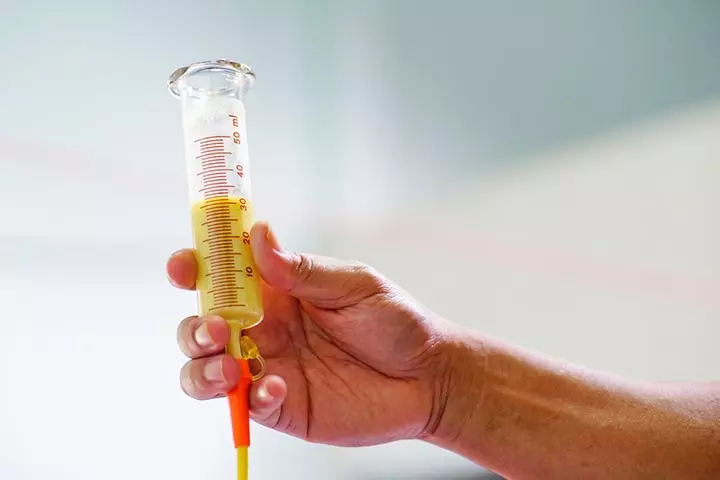
Image: Shutterstock
- Gastrointestinal defectsiThe disorders of the digestive system.
- Electrolyte imbalanceiHigh or low levels of certain salts and minerals in the body. and problems
Becky, a primary school teacher and mother, talks about the feeding difficulties her daughter (Isla) faced because of being born with a cleft palate. She says, “When she was born, she was in the neonatal unit and couldn’t feed at all initially, so as well as being on a glucose drip, she also had an NG tube placed. Babies with a cleft palate often have no suction, so they need specialist bottles & feeding methods to be able to feed by themselves. Isla struggled with this more than some, and feeding really tired her, initially expending more calories feeding than she was eating (i).”
Being premature or sick may make it difficult for newborns to feed themselves. In such cases, feeding tubes are a safe and efficient way to provide nutrients and medicines to the body.
Types Of Feeding Tubes
There are various feeding tubes types for enteral feeding. These may include (2) (3):
- Nasogastric tube (NG) is a tube that is passed through the nose into the stomach. It is usually used to feed for two to four weeks.
- Nasojejunal tube (NJT) is a tube that is passed through the nose to part of the small intestine called jejunum (second part). NJT tubes are recommended if the baby has problems with emptying the stomach, pancreatic surgery, or any blockage.
- Jejunostomy tube (JEJ) is a tube that is inserted directly into the jejunum through a hole in the belly. It is usually used for babies after esophageal (food pipe) or gastric (stomach) surgeries. The tubes can be of two types — the percutaneous endoscopic jejunostomy tube (PEJ) and the radiologically inserted jejunostomy tube (RIJ). PEJ tubes are inserted under endoscopic guidance, and RIJ tubes are X-ray guided.
- Gastrostomy tube (G-tube) is a tube that is inserted directly into the stomach through a hole in the belly. It is often used for feeding. It can be a radiologically inserted gastrostomy tube (RIG) or percutaneous endoscopic gastrostomy tube (PEG), depending on the imaging technique used.
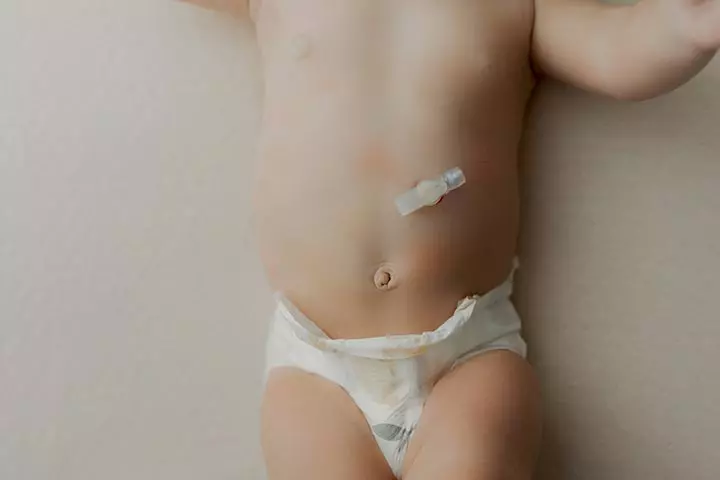
Image: IStock
- Orogastric tube (OG) is a tube that is passed through the mouth and into the stomach. It is similar in purpose to a nasogastric tube. An orogastric tube could be preferred in cases where the baby has nasal problems or has other nasal intubations.
Pediatricians choose the feeding method and the type of tube based on the baby’s health condition. In addition, they may also determine the feeding duration, feeding frequency, and feeding volume. Some may require imaging tests before tube insertion to examine the digestive system. Babies with more feeding complications are provided with parenteral nutritioniWay of providing the body with nutrition through the veins. , that is, the administration of nutrition into the bloodstream through a vein.
How Is A Feeding Tube Placed?
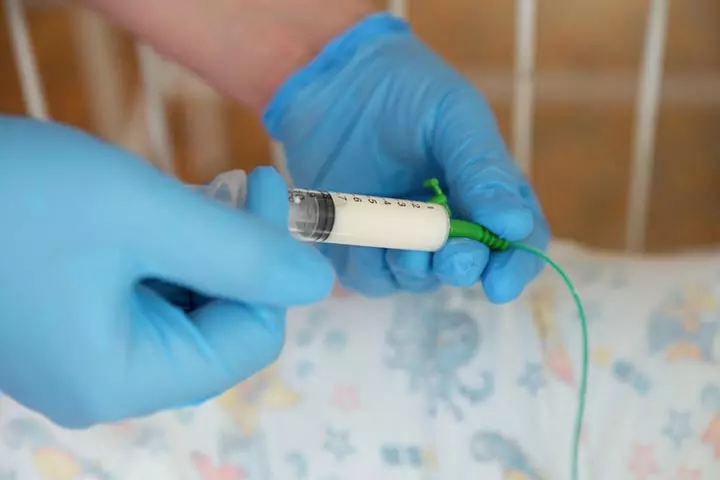
Image: Shutterstock
A feeding tube is placed through the nose or mouth after measuring the estimated length from the tip of the nose to the bottom of the ear lobe and from the ear lobe to a point between the sternum (breastbone) and belly button. Usually, the feeding tube placement is confirmed by auscultationilistening to sounds of the body for a medical examination, typically using a stethoscope. or X-ray. Doctors may listen over the stomach after pushing some air into the tube using a syringe.
Feeding tubes may often be placed into smaller intestines for babies with severe feeding problems to provide continuous and slower feeding. Feeding tubes can aid in feeding formula or breast milk to the baby.
 Things to know
Things to knowPrecautions To Take When Tube Feeding Your Baby At Home
If your baby is put on nasogastric tube feeding, here are a few safety tips you should consider (9).
- Learn the proper techniques from your healthcare team before attempting it at home.
- Wash your hands and place your baby in a comfortable position before feeding.
- Read the instructions and test the tube.
- Draw the required milk as per your doctor’s guidelines, and position the tube correctly to avoid choking.
- Watch for any discomfort or signs in your baby.
- After feeding, disconnect the tube, seal it, and clean all equipment as instructed.
What Are The Risks Of A Feeding Tube?
Feeding tubes are mostly safe. The insertion of the feeding tube might cause some irritation or discomfort to the baby.
Similarly, an incorrectly placed tube can also cause the baby to be uncomfortable. A misplaced feeding tube may increase the risk of the following medical problems in infants (4).
- Bradycardia (slow heart rate)
- Breathing issues
- Coughing

Image: Shutterstock
- Spitting up or vomiting
- CyanosisiA condition in which a shortage of oxygen in the blood causes the skin, lips, or nails to turn blue. around the mouth
- In rare cases, incorrect insertion may cause a puncture in the stomach
 Point to consider
Point to considerDespite correct placement, some babies may experience the following issues with feeding tubes.
- Irritation of nose and mouth
- Stomach irritation
- Minor bleeding
- Nasal infections
- Stuffy nose
Prolonged use of feeding tubes is also known to increase the risk of neurodevelopmental delays in infants (10). Therefore, work with your child’s healthcare providers to manage feeding challenges effectively and prevent long-term complications.
How Long Can A Baby Be On A Feeding Tube?
The feeding tube can be left for months in infants. However, if the tube comes out before a month, the healthcare provider may check for the tube’s condition. If the tube is soft and not damaged, it can be rinsed using suction and placed back into the stomach. Regular feeding tube cleaning is vital to avoid feeding tube clogging and ensure proper feeding tube care.
New tubes are placed if the end of the tube becomes hard or damaged. The tube feeding is continuous until the baby can feed themselves or until any interventions are done to resolve the feeding difficulties.
A study conducted by multiple institutions revealed that approximately 2.5% of preterm infants were discharged with NG-tube feeding at home. The rates of home NG-tube feeding varied significantly, ranging from 0% to 12%. Infants with higher gestational age were less likely to receive home NG-tube feeding, while the likelihood increased for those with longer mechanical ventilation duration and higher illness severity at birth. Moreover, the probability of home NG-tube feeding was higher in cases of smaller-than-expected size, male gender, severe brain injury, and bronchopulmonary dysplasia. These findings provide valuable guidance to healthcare providers in selecting appropriate feeding methods for preterm infants.
If a baby needs feeding tubes for a longer duration due to medical conditions, pediatricians may opt to place a gastronomy tube or G-tube instead of a nasogastric or orogastric tube. This is established through small surgical procedures and kept until the baby requires it.
Frequently Asked Questions
1. Can a baby be discharged with a feeding tube?
Yes, your baby can be discharged with a feeding tube, but you must be prepared to feed and care for your baby. You can also request the assistance of a nurse when changing the feeding tube at home (5).
2. Can I be involved in caring for my baby if they are being tube fed?
Yes, you and your partner can be involved in taking care of your baby with a feeding tube if you’re comfortable enough. With the help of a neonatal nurse, you can eventually gain confidence in positioning the baby correctly, administering tube feeds as per the feeding schedule, and also practicing skin-to-skin contact with your baby if possible (5).
3. How often should an infant on a feeding tube be monitored?
The frequency of monitoring an infant feeding tube and its parameters depend upon the diagnosis and underlying condition of the infant. Parameters such as bowel, medicines, insertion site, and intake of certain nutrients may require daily monitoring, while others may require weekly monitoring. In the case of long-term enteral feeding, the caregivers may be educated to monitor these parameters themselves (7).
4. How is an infant feeding tube removed?
For the feeding tube to be removed, your baby’s doctor may remove it themselves or instruct you to remove it. The tape first needs to be loosened, and the tube must be pinched to avoid breathing stomach contents. The tube may then be gently pulled out of the nostrils. Changing the tube should ideally be done once a month if it doesn’t already get clogged or damaged (8). Note that this removal technique is applicable to a nasogastric tube. So, you may ask your doctor for the removal of other types of feeding tubes.
Feeding tubes for infants can help provide feeding support to babies who can’t consume food due to gastrointestinal issues or have difficulty swallowing food. You may also consider a feeding tube for a baby not gaining weight. Use a feeding tube for your baby for a while after consulting a healthcare provider. However, once they grow up and can eat properly, you may do away with it to check if your baby is doing fine. It is essential as feeding tubes can affect a baby’s digestion. Thus, it should be used only when essential for survival. If you continue using it for a long duration, ensure it is extremely clean to prevent the baby from catching any unwanted feeding tube infections.
Infographic: Tube Feeding For Infants At Home
Doctors may recommend tube feeding for newborns at home for multiple reasons, such as if the baby is a preemie who has crossed 33 weeks of gestational age. A baby’s ability to feed and gain weight is also considered before recommending tube feeding at home. It is important for parents or caregivers to learn feeding methods, preparation, and precautions before discharge. Go through the below infographic to know the steps of nasogastric tube feeding at home.
Some thing wrong with infographic shortcode. please verify shortcode syntax
If you desire to learn the basics of caring for a child with feeding tubes. Watch this video to get some tips on how to make the process easier and more comfortable for your child.
Personal Experience: Source
MomJunction articles include first-hand experiences to provide you with better insights through real-life narratives. Here are the sources of personal accounts referenced in this article.
i. Life with a feeding tube;https://incredibleislablog.wordpress.com/2017/06/19/life-with-a-feeding-tube/
References
1. Feeding Tube-Infants;; MedlinePlus; US National Library of Medicine
2. Types of Tube Feeding; Cancer Research UK
3. Chris Nickson, Nasogastric and Orogastric Tubes; LITFL
4. Nasogastric Tube Feeding; Children’s Hospital Minnesota
5. Tube feeding; Bliss for babies born premature or sick.
6. Nasogastric tubes; The Royal Children’s Hospital Melbourne
7. Enteral Feed Monitoring; BAPEN UK
8. Nasogastric Tubes (Insertion and Feeding); Nationwide Children’s
9. Nasogastric tube feeding at home; NHS; Cambridge University Hospitals
10. Ranjith Kamity et al., (2025); Feeding Problems and Long-Term Outcomes in Preterm Infants—A Systematic Approach to Evaluation and Management; Children
Community Experiences
Join the conversation and become a part of our nurturing community! Share your stories, experiences, and insights to connect with fellow parents.
Read full bio of Pranjul Tandon
Read full bio of Dr Bisny T. Joseph
Read full bio of Rohit Garoo
Read full bio of Shinta Liz Sunny







